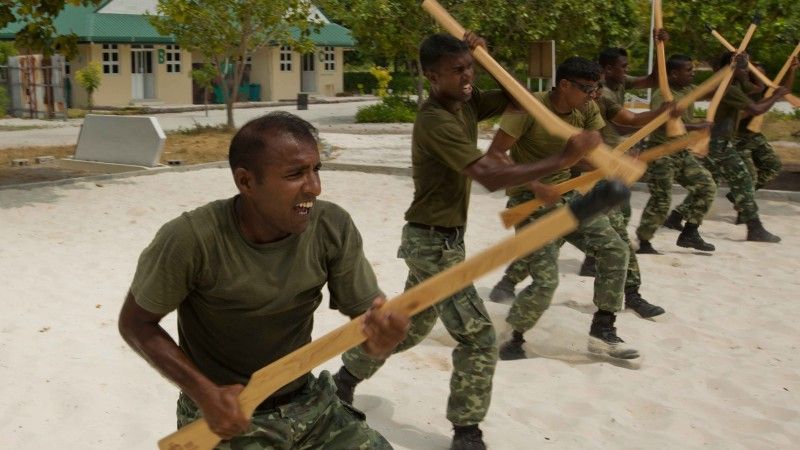Strategic gameplay around a tourist paradise [COMMENTARY]

Modern complicated relations between the People’s Republic of China and India face several strategic challenges, including military ones. It refers not only to the Line of Actual Control (LAC) between the two Asian nuclear powers but also to the broader regional race to acquire or take over foreign partners. The newest element of this competition may be the conventional tourist paradise, the Maldives.
We might see another potential flashpoint that has emerged in relations between two leading Asian powers - the People’s Republic of China (PRC) and India. These are the Maldives, known in Poland primarily for their tourist attractions. In January 2024, the president of this country, Mohamed Muizzu, asked the Indian side to hastily withdraw all soldiers and military personnel from his country (some sources claim that it is March 15, although no specific date was officially indicated, only emphasized the need to do it quickly). India had previously sent troops on a humanitarian mission and to support medical evacuation procedures. At the same time, the strategic cooperation with the Maldives guaranteed the Indian Navy and Air Force, and probably the intelligence services (for instance, RAW) strategic support in regional activity. The Maldives could count on Indian assistance, e.g., in the context of the crisis response after the 2004 tsunami and in the era of the 2020 pandemic threat.
Read more
Maldives strategic dilemmas
The whole issue of tensions in bilateral relations is complicated because it includes primarily the already mentioned Indian-Chinese threads and the specificity of political divisions within the Maldivian political scene. Therefore, we should start with issues typically related to political competition. The Maldivian Democratic Party, led by former president Mohammad Solih, who is described as pro-India, won the election for mayor of the capital city of Malé on January 13. It was a significant defeat of the presidential party of the People’s National Congress and of M. Muizzu himself, who is described as a pro-China politician (and, above all, a politician who strongly criticizes India - the famous slogan ” India out!” during the campaign). It is another obstacle since President M. Muizzu must consider cohabitation in relations with the national parliament (People’s Majlis), where his opposition still has the advantage. Moreover, the current president has been in office for a short time, as he has been in office since November 2023. As the opposition emphasizes, he has already received a social vote of no confidence in his policies.

Photo. U.S. Army, Spc. Jacob Núñez, public domain
Then, we can move on to strategic matters relating to the India-China rivalry. In January, Mohamed Muizzu traveled to the PRC on a five-day state visit. Moreover, on January 10, the signing of 20 key agreements between the two states was announced, including those relating to the strategic sector of the Maldivian economy, i.e., tourism (strategic for the Maldives). But it was also said that the authorities in Beijing were ready to provide financial assistance of an undisclosed amount. In addition, there were announcements relating to developing a cooperation plan in the Belt and Road Initiative field, as well as in digital, infrastructure, and road construction matters.
Read more
Let us note that similar activities almost always accompany the expansion of China’s spheres of influence in various regions of the world (not only in Asia but also in Africa). Therefore, none of these possible agreements should be treated without a strategic context. Let’s look at the issue of digital technologies and digital transformation. The PRC has a gigantic database of companies offering almost all hardware and software solutions. But their mass introduction to the Maldives will raise doubts about the use of this digital relationship by the authorities in Beijing to control/spy/surveillance of the weaker partner.
Especially when, at the same time, India is undergoing something of a trial of strength with Chinese digital technologies, all in the context of the crisis on the border between India and the PRC in 2020. We also need to mention the specific model of Chinese activity in the dimension of the civilian infrastructure of other countries, which ultimately also translates into the security and defense dimension (critical infrastructure, energy sector, harbors, etc.). It should be emphasized that the Chinese host ensured a complete celebration when receiving the president of a country with less than half a million inhabitants.
"Touristic" conflict with India in info domain
President Mohamed Muizzu also sought to increase tourist traffic from the Chinese side in the PRC. Because while relations with the authorities in Beijing were warming, there was a visible decline in Maldivian-Indian relations. India-Maldives relations have been under pressure due to the information domain use. First, Indian Prime Minister Narendra Modi published photos in the Indian Lakshadives, which was perceived as an attack on the tourist potential of the Maldives (India is supposed to see the islands mentioned above as an untapped resource for tourism). Subsequently, three members of M. Muizzu’s government began making public comments about Prime Minister Modi in a style India considered an insult to its political leader. The next stage was a flood of radical remarks on social media.

Photo. U.S. Navy, Mass Communication Specialist 1st Class David McKee, public domain
Although Maldivian politicians were ultimately suspended (Malsha Shareef, Mariyam Shiun, and Abdulla Mahzoom Majid) and pointed out that their statements did not represent the government’s position, the tension continued to grow. This situation resulted in calls in the Indian media and political debate for tourists to skip the Maldives.
Read more
The Maldives consists of just over 200 inhabited islands, with two main cities - the capital Malé and Addu City. But the key here is not the 298 square kilometers of land but the location in the Indian Ocean, especially in the context of India’s security strategy and its freedom of navigation in this region of the world. One can imagine the repercussions of establishing a radar or SIGINT center of the PRC in the Maldives, even if it were camouflaged under the activities of civilian agencies caring for the natural environment, maritime security, or similar, at first glance, neutral forms of activity. We can also mention the possibility of a larger presence of Chinese cover companies, which could provide significant intelligence gains for the PRC’s special services.
For now, it would be difficult to assume that, given the problems of President M. Muizzu »s party, a full-fledged military facility belonging to the Chinese People’s Liberation Army (PLA) could be established. But it is better possible to imagine the behavior of the Chinese fleet, analogous to the Indian actions, which could often visit this country on humanitarian missions and provide assistance in crisis response (including exercises).
Read more
Moreover, we can safely assume the possibility of expanding cooperation with the Maldives in the field of Chinese transfers of equipment for the 4,000-strong National Defense Forces - especially when it comes to communications equipment, imaging equipment and, moreover, equipment for the Coast Guard and Marines.
The US and India are watching PRC moves carefully
In this context, M. Muizzu’s attitude to the PRC towards the 2020 defense agreement with the USA may be very interesting. The Americans (USMC and SOF) have thus become essential in training local uniformed forces, especially in the context of Muizzu’s predecessor’s Composite Training Center on Maafilaafushi Island. However, Indian military activity was still crucial. India had donated a significant patrol ship to the Maldives, is also responsible for expanding the said training center, and has provided visible training support to the Maldivian forces over the years. In 2016 and 2019, both countries held crucial meetings in dialogue on defense cooperation issues. However, 2019 played a strategic role in calming down the disputes over the Indian military presence that emerged in 2018.
Read more
For now, the Indian side is toning down its emotions regarding relations with the Maldives and their potential rapprochement with the PRC. Significantly, Indian politicians say that the Maldives people are generally positive towards the Indian side. The local election result may indicate that, for now, M. Muizzu’s pro-Chinese policy may not have any long-term implications.
However, we must consider the importance of agreements with the Chinese state and its companies, which may be signed before the next general elections. Moreover, the importance of China’s direct and indirect presence in this region of the Indian Ocean is more than just China’s attempts to break small countries out of their relations with Taiwan (mainly a symbolic space, but based on similar tools). In the case of the Maldives, security and freedom of navigation are of direct importance, above all, in the intelligence sphere. If the Maldives borrowed money from the People’s Republic of China and their tourism became dependent on political decisions in Beijing, the situation would be highly complicated for India and the USA.
Read more
Another important aspect is the possible impact on India’s position as a rising power. The Maldives are essential both strategically and symbolically. For example, for the Indian army, their 1988 operation in the Maldives is still an important element of building armed forces ethos and pointing to the case of power projection by newborn regional power. In the year mentioned above, Indian paratroopers (50th Independent Parachute Brigade) using the Il-76 transport prevented a coup in the Maldives. The Indian Navy also provided practical support, especially navy vessels INS Betwa and INS Godavari. Hence, considering India’s attitude, we must remember psychological factors in its decision-making processes regarding the issue of the Maldivian-China rapprochement.
PRC test the limits in relations with Maldives?
The material related to the Maldives was originally prepared on January 17, 2024. We can already see that the actual activities of the Chinese and Maldivian sides largely confirm the hypotheses contained therein. The Maldives government has consented to the Chinese research vessel Xiang Yang Hong 3 to use the local port infrastructure and renew its supplies. The authorities in Beijing thanked for this gesture, emphasizing that thanks to this bilateral cooperation is deepening and the Maldives can be considered a friendly country in the region.
However, the Chinese authorities stipulate that the ship will not conduct any research or measurements in the waters of the Maldives. It is essential because similar Chinese entities have caused a dispute in the case of Sri Lanka.
Read more
Of course, India is particularly concerned and is monitoring the movements of the Chinese ship closely. Two issues may be problematic if we consider the activities of vessels such as the Xiang Yang Hong 3. The first is the possibility of dual purpose of research vessels, i.e., using their equipment to camouflage, e.g., espionage systems, for example, in the field of SIGINT and more than just obtaining data for „scientific” analyses. Moreover, scientific and measurement work (MASINT) may translate into better mapping of the water area for the subsequent navy activity belonging to the Chinese People’s Liberation Army. The second aspect is the race for undersea natural resources. Especially regarding the possibility of another jump to the undersea riches of this region, including rare earth metals and not only previously mined energy raw materials.










